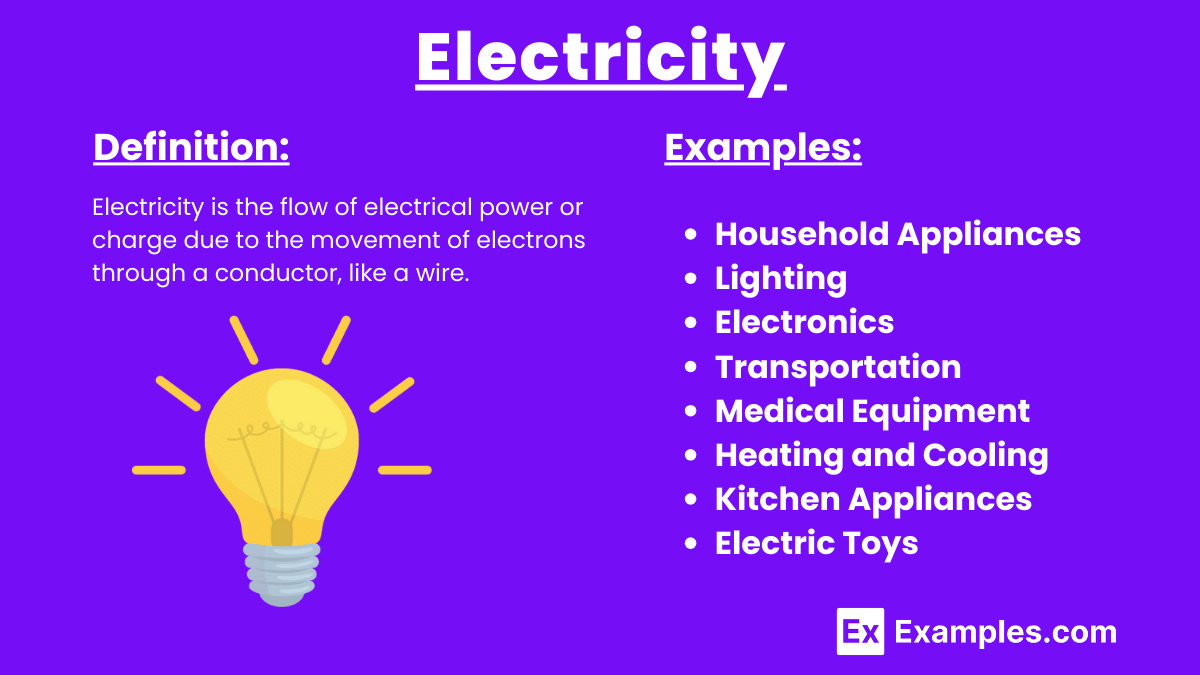What is the unit of electric current?
Volt
Ohm
Ampere
Watt


Electricity is the flow of electric charge in conductors like wires, powering devices and systems. It’s generated through batteries, hydroelectric plants, fossil fuels, and renewable resources, and measured in units such as volts, amperes, and watts. Key concepts include static electricity formula (F = k * (q1 * q2) / r^2) and electromagnetism, which studies the relationship between electric currents and magnetic fields. Electricity is vital for modern life and technological advancements.
Electricity is the flow of electrical power or charge due to the movement of electrons through a conductor, like a wire. It powers devices and systems, such as lights, appliances, and computers. Generated from sources like fossil fuels, nuclear power, and renewable energy, electricity is essential for modern life.

| Aspect | Current Electricity | Static Electricity |
|---|---|---|
| Definition | Flow of electric charge through a conductor | Accumulation of electric charges on a surface |
| Movement of Charges | Continuous flow of electrons | No continuous flow; charges remain static |
| Direction | Can be unidirectional (DC) or bidirectional (AC) | Charges are stationary until they discharge |
| Generation | Generated by power sources like batteries or generators | Generated by friction, contact, or separation of materials |
| Example | Household electrical systems, electronic devices | Lightning, rubbing a balloon on hair, static shock |
| Measurement | Measured in amperes (A) | Measured in volts (V) |
| Uses | Powers devices, machinery, and household appliances | Limited practical use; mainly observed as a natural phenomenon |
| Duration | Continuous as long as the power source is connected | Temporary, dissipates after discharge |
| Energy Form | Kinetic energy of moving electrons | Potential energy due to accumulated charges |
Electricity is a versatile and essential energy source in modern life. Its applications span across various fields, improving our quality of life and driving technological advancements. Here are some key applications of electricity:
Electricity powers numerous household appliances and systems, making daily life convenient and comfortable. Key applications include:
Electricity is crucial in manufacturing and production processes. Key industrial applications include:
Electricity is revolutionizing transportation, contributing to sustainability and efficiency. Key applications include:
Electricity is the backbone of modern communication and IT systems. Key applications include:
Electricity plays a vital role in healthcare, enhancing diagnostic and treatment capabilities. Key applications include:
Electricity is generated through power plants using coal, natural gas, nuclear, hydroelectric, wind, or solar energy to produce electrical energy.
A conductor is a material that allows the flow of electrical current, such as copper or aluminum, due to its low resistance.
An insulator is a material that resists the flow of electric current, like rubber or plastic, used to protect against electrical hazards.
Voltage, measured in volts (V), is the electric potential difference between two points and drives the flow of electric current in a circuit.
Current, measured in amperes (A), is the flow of electric charge through a conductor, representing the rate at which the charge passes a point in the circuit.
Resistance, measured in ohms (Ω), is the opposition to the flow of electric current in a material, affecting how much current flows for a given voltage.
Ohm’s Law states that the current (I) through a conductor between two points is directly proportional to the voltage (V) and inversely proportional to the resistance (R): I = V/R.
A circuit is a closed loop that allows electric current to flow, consisting of a power source, conductors, and a load, like a light bulb or motor.
In a series circuit, components are connected end-to-end, so current flows through each one sequentially. In a parallel circuit, components are connected across common points, providing multiple paths for current.
A short circuit occurs when a low-resistance path bypasses part of a circuit, causing excessive current flow that can lead to overheating and damage.
Text prompt
Add Tone
10 Examples of Public speaking
20 Examples of Gas lighting
What is the unit of electric current?
Volt
Ohm
Ampere
Watt
Which of the following is a conductor of electricity?
Rubber
Glass
Copper
Plastic
What is Ohm's Law?
Voltage = Current × Resistance
Power = Voltage × Current
Resistance = Voltage / Current
Current = Power / Voltage
What is the function of a resistor in an electrical circuit?
To store energy
To increase current
To oppose the flow of current
To convert AC to DC
Which device is used to measure electric current?
Voltmeter
Ammeter
Ohmmeter
Multimeter
What is the unit of electrical resistance?
Watt
Volt
Ohm
Ampere
Which of the following materials is an insulator?
Silver
Aluminum
Rubber
Iron
What type of current flows in one direction only?
Alternating Current (AC)
Direct Current (DC)
Static Current
Pulsating Current
What is the purpose of a fuse in an electrical circuit?
To increase voltage
To protect against overcurrent
To store electrical energy
To reduce resistance
Which law states that the total current entering a junction equals the total current leaving the junction?
Ohm's Law
Kirchhoff's Voltage Law
Kirchhoff's Current Law
Coulomb's Law
Before you leave, take our quick quiz to enhance your learning!

